The past two years of full-scale war are not only the most shameful time in Russian history. They also show how the entire Putin government is permeated with lies and hypocrisy. Attempts to create some kind of racially pure Russian culture or even cuisine to spite Western civilization turned out to be just the usual plundering of the country’s budget.
Russian cuisine has always been open to foreign experience. But the current round of self-isolation has quite predictable features. Our fellow citizens who survived the USSR know very well what worship of the West is and what it leads to. In the twilight of Putin’s rule, the words “liberal” and “Parmesan” have become almost synonymous.
Today it is ingenuous to deny the French influence on the development of Russian cuisine. But we should not forget that Finno-Ugric, Tatar and Polish cuisines had just as much influence on it. This has been forgotten only because it happened so long ago. And now the recent defeat of the Russian Foreign Ministry in the battle for Ukrainian borscht has only strengthened official anger towards everything foreign.
In our writings we have sometimes compared the development of cuisine with other parts of our culture. For example, linguists say that the Russian language might consist of up to 60 percent borrowed words. Why would the situation with cuisine be different? There is no cause for indignation. The same linguists say that English consists of 80 percent borrowed words, and it doesn’t bother English speakers at all. They continue speaking and writing English, and no one complains about a vast world conspiracy.
Here’s a particularly vivid illustration of how useful foreign culinary “borrowings” have been: the ordinary frankfurter or weiner, what Americans and now much of the world calls hotdogs. In the Soviet Union they were the food of bachelors and students, taken on weekend camping trips, fried in dough, sold in cafeterias. In the USSR, there were even special cafes for them with an explanatory name something like “Hotdogeries.” Hotdogs were universal. And there probably isn’t a soul in the country who wasn’t saved from hunger in rough times by the ubiquitous hotdog.
Our compatriots have known some kind of wiener or frankfurter for quite a long time. The first dishes similar to it probably arrived in the Petrine era from Holland and Germany. Wieners and beer were served for foreign sailors and skippers in the first inn opened in St. Petersburg at the beginning of the 18th century. Then the former cook of Peter the Great, German Felten, founded an establishment in the city called “Osteria of Four Frigates.” The menu hasn’t come down to us, but we can be sure that some analog of modern sausages and franks were served there.
But as time went on, the Russian sausage developed differently. It is clear that most recipes were unpretentious products made of pork, bacon and spices. They could be found 100 years later in sausage makers’ establishments in St. Petersburg and Moscow. For example, “The newest and most comprehensive index of Moscow” published in 1829 notes that Mattern’s establishment on Mokhovaya Street sold “English sausages made to order.” And Bezozzi’s “near Kuznetsky Most” offered “truffle sausages.”
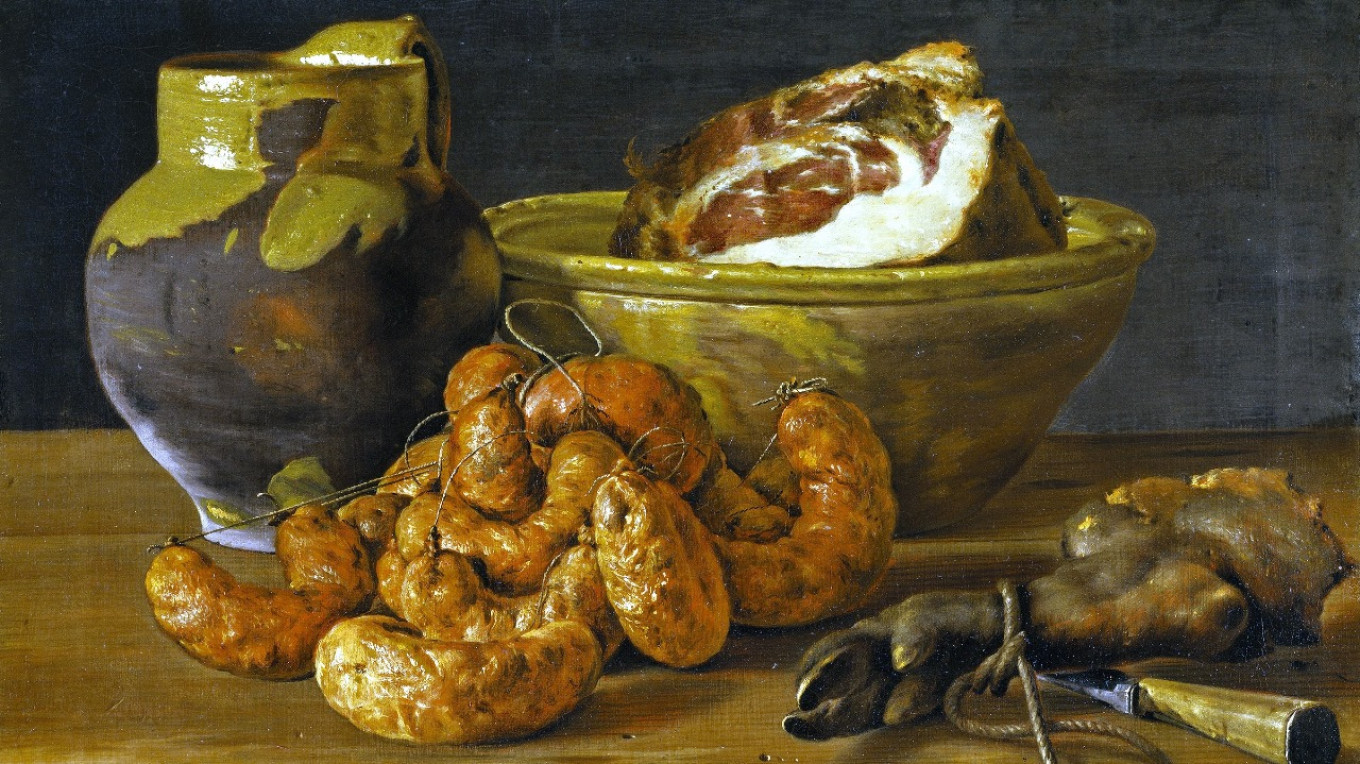
Why did we adopt the French name of the dish — sosiska (сосиска) from the French saucisse? Simple: sosiska was mass-produced in the middle-class cuisine in the late 18th and early 19th centuries. This was when connections with French cuisine and culture were at their peak. And after tens of thousands of Russian soldiers and officers were in France during the Napoleonic Wars, the cuisine of this country turned from an aristocratic court delicacy into the favorite dishes of more common people.
But at the same time, in Russia sausages were evolving to be more elegant. For example, the cookbook of Ignaty Radetsky, the great master of Russian gastronomy of the 19th century, includes “hare sausages.” The sausages were “fried in oil, and when ready, removed to a plate, deglazed, cooled on ice, then covered with cubes of meat aspic.”
And in Yekaterina Avdeyeva’s “Handbook for the Experienced Housewife,” published in St. Petersburg in 1842, here are sausages that are the apotheosis of imagination and indulgence:
Goose liver sausages: Grate goose livers, add a few handfuls of grated white bread, half a cup of heavy cream, soy, nutmeg, a quarter of a pound of melted crawfish butter, a cup of red wine and mix everything together well. Then chop a few shallots, cook them a little in the crawfish butter, add four egg yolks, and stir. Fill sausage casings with this mixture and boil in broth.
But, interestingly enough, everyday cuisine for the common folk was developing, too. As sausages became commonly available, they were adapted to local taste.
If you think that hotdogs in a roll are today’s fast food, think again! We found similar recipes at the end of the 19th century. For example, in the book “House and Economy” (St. Petersburg, 1895) Maria Redelin gives the following recipe:
Wrap the sosiski in dough, place on a greased baking sheet, let them continue to rise for 1.5 hours, then baste with egg and bake at first in a moderate and then a hot oven. Serve them as an appetizer or with bouillon.
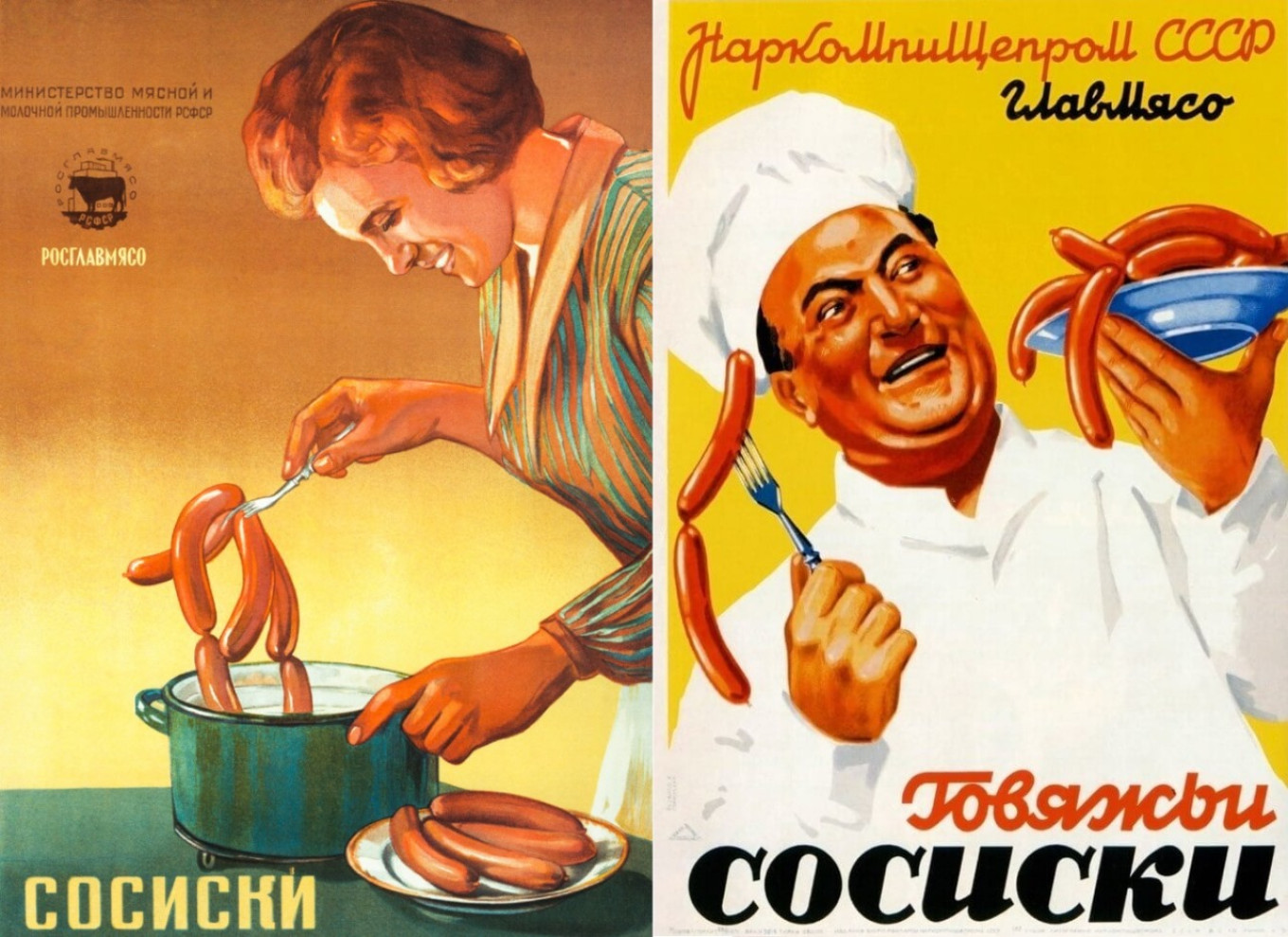
By the middle of the 19th century in Russia, sausages (sosiski) were nationally famous. Literary writers glorified them. Kuprin praised sausages in hot water; Pisemsky sang praises to sausages with cabbage. Tolstoy considered sausages to be a good appetizer with wine, Goncharov mentioned sausages with peppers. Finally, Mikhail Saltykov-Shchedrin enumerated a whole list: “O! Sausages! How many ways can they be prepared?!” he wrote in 1876, “Sausages in Madeira, sausages with garlic, sausages with cream, sausages with sauerkraut, sausages … oh sausages… are everything!”
It’s very clear that everyone loved these Russian hotdogs, and so many of the recipes seem familiar. But if we open “Russian Cookery” (1795-98) by Vasily Lyovshin, we will find something called “sotsyska” (соцыска). This was a piece of meat, pounded thin, covered with finely diced onions, vegetables, lard, and spices. Then the meat was rolled up, held tight with a toothpick, stewed gently and then served. Lyovshin writes: “Make them like sausages,” which is odd because they are clearly zrazy. It’s strange that they were compared to sausages 200 years ago.
In the USSR the love for sausages and hotdogs did not die down, but only grew. In the book “Sausages and Smoked Meat” written in 1938, all kinds of sausages are described: pork, beef, dairy, Russian-style. The ingredients in Soviet hotdogs make your head spin: beef — forty kilograms; pork — sixty; salt, saltpeter, sugar, white pepper, nutmeg. Shelf life — five days. You can’t even dream of something like that these days.
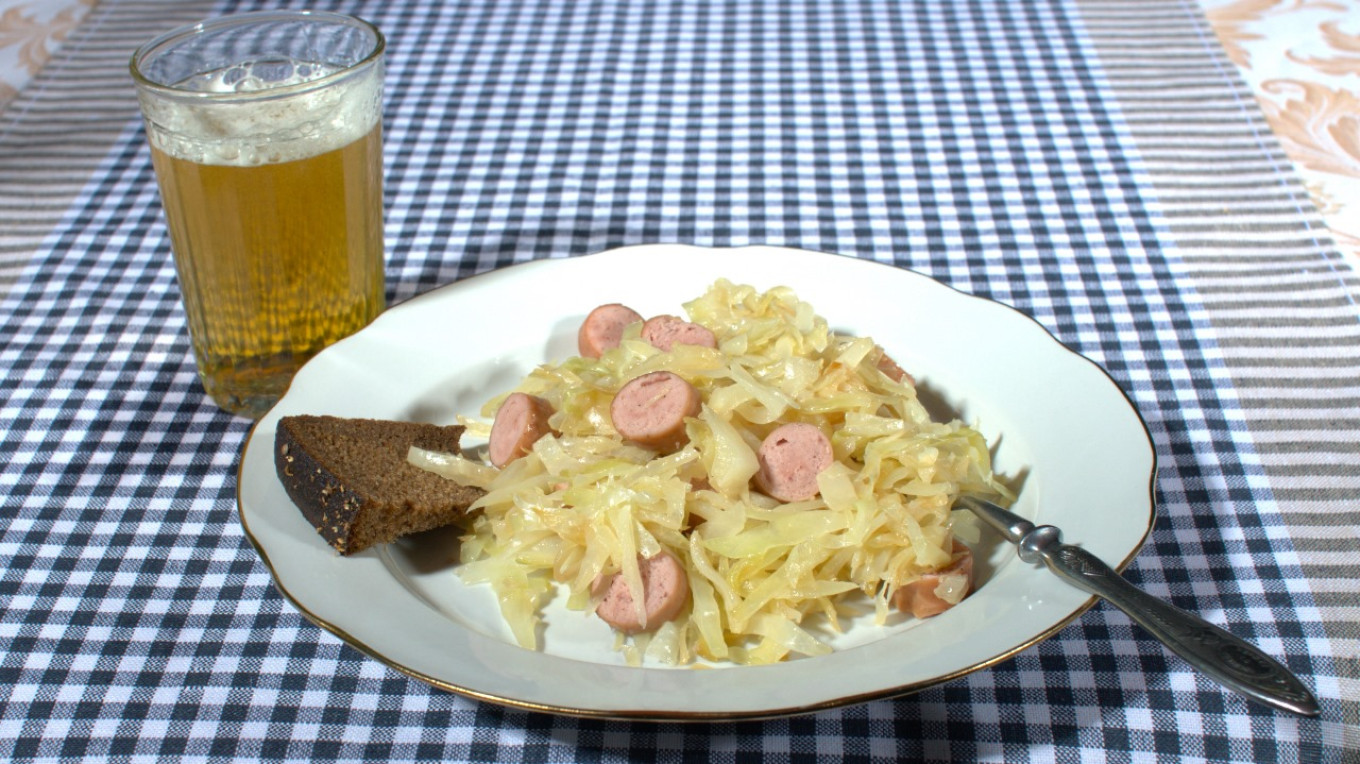
In the first edition of “The Book of Tasty and Healthy Food” (1937), food industry commissar Anastas Mikoyan even shared a curious scene that played out in the Kremlin: “I once told Comrade Stalin that I wanted to raise production of hotdogs. Comrade Stalin approved of this decision, noting that in America hotdog factories have gotten rich from this business, in particular, from the sale of hotdogs in stadiums. They became millionaires — hotdog kings. Of course, comrades, we don’t need kings, but we need to intensify our hot dog production.”
But today we’ll go back a couple of centuries and try to cook the “sotsyski” mentioned by Vasily Lyovshin in 1795.
Ye Olde Russian Hotdog
Makes 16 roll-ups
Ingredients
- 1 kg 500 g (3 1/3 lb) beef (ideally, tenderloin)
- 3 onions
- 2 medium carrots
- 1 parsnip root
- 150 g (5.25 oz or 2 c) mushrooms (white or whatever is on hand)
- 3 eggs
- 50 g (3 ½ Tbsp) butter
- 100 g (7 Tbsp) melted butter
- 500 ml (½ quart) beef stock
- 100 ml (scant ½ c) white wine
- Cloves
- Herbs: parsley, basil
- Ground pepper, salt

Instructions
- Fry the mushrooms and onions in butter. Cool slightly.
- Grind mushrooms together with 300 g (10.5 oz) of the meat in a meat grinder.
- Add egg yolks, finely chopped basil and parsley to the mince. Salt, pepper and mix.
- Cut thin slices of meat (1 cm or 1/3 inch) from a large piece and pound thin.
- Salt and pepper the beaten slices and spread the mushroom stuffing on them.
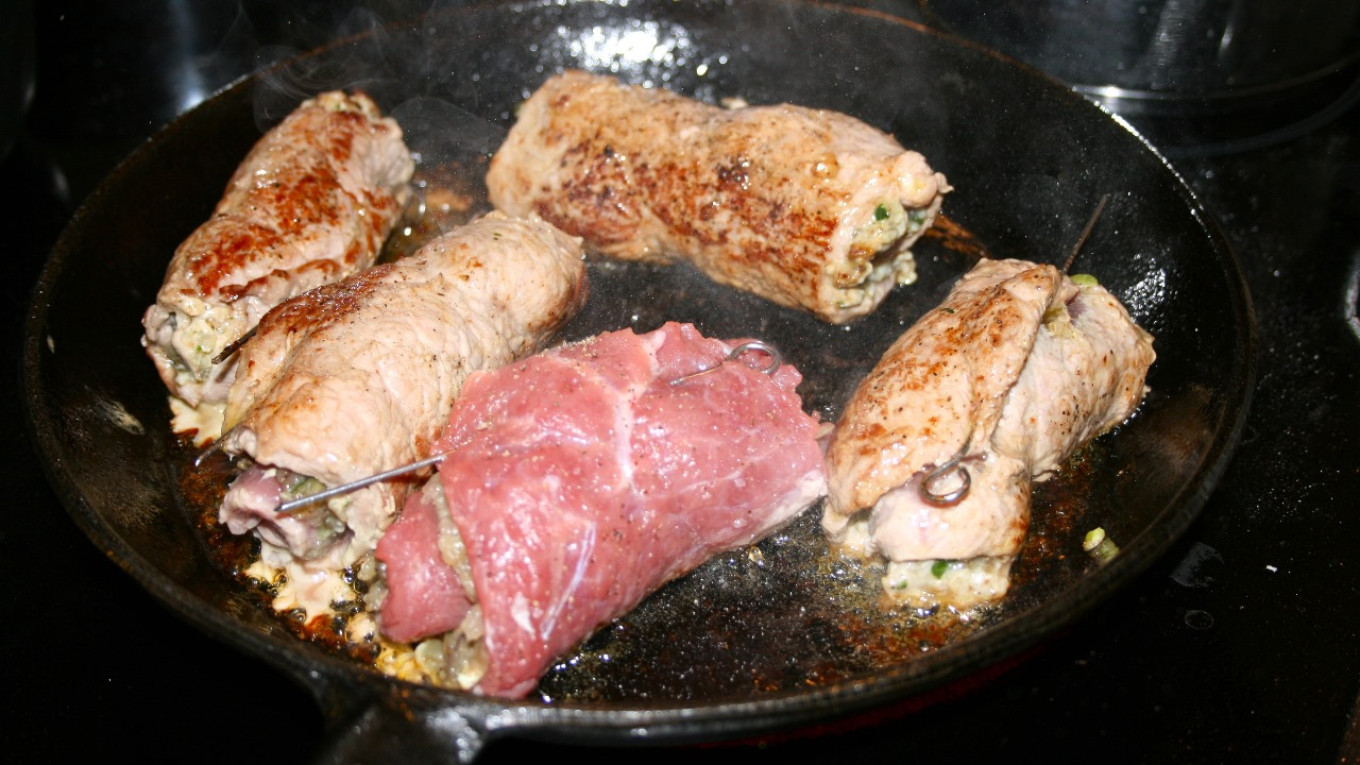
- Roll up, fasten with toothpicks and fry in a frying pan with melted butter.
- Put the rolled meat in a pot, then pour in broth and wine, add chopped onions, carrots, parsnips, cloves, salt and pepper. The liquid should cover the roll-ups.
- After bringing to a boil, lower the heat and simmer for 40 minutes.
Stewed cabbage
Ingredients
- 1 kg (2.2 lb) sauerkraut
- 2 onions
- 100 g (7 Tbsp) melted butter
- 50 ml (scant 4 c) wine vinegar
- 100 g (1/4 c) honey
Instructions
- If the sauerkraut pieces are big, cut into smaller pieces.
- Slice the onion into thin quarter rings.
- Sauté the cabbage and onion in heated melted butter until golden.
- Add vinegar and honey, adjust to desired flavor.
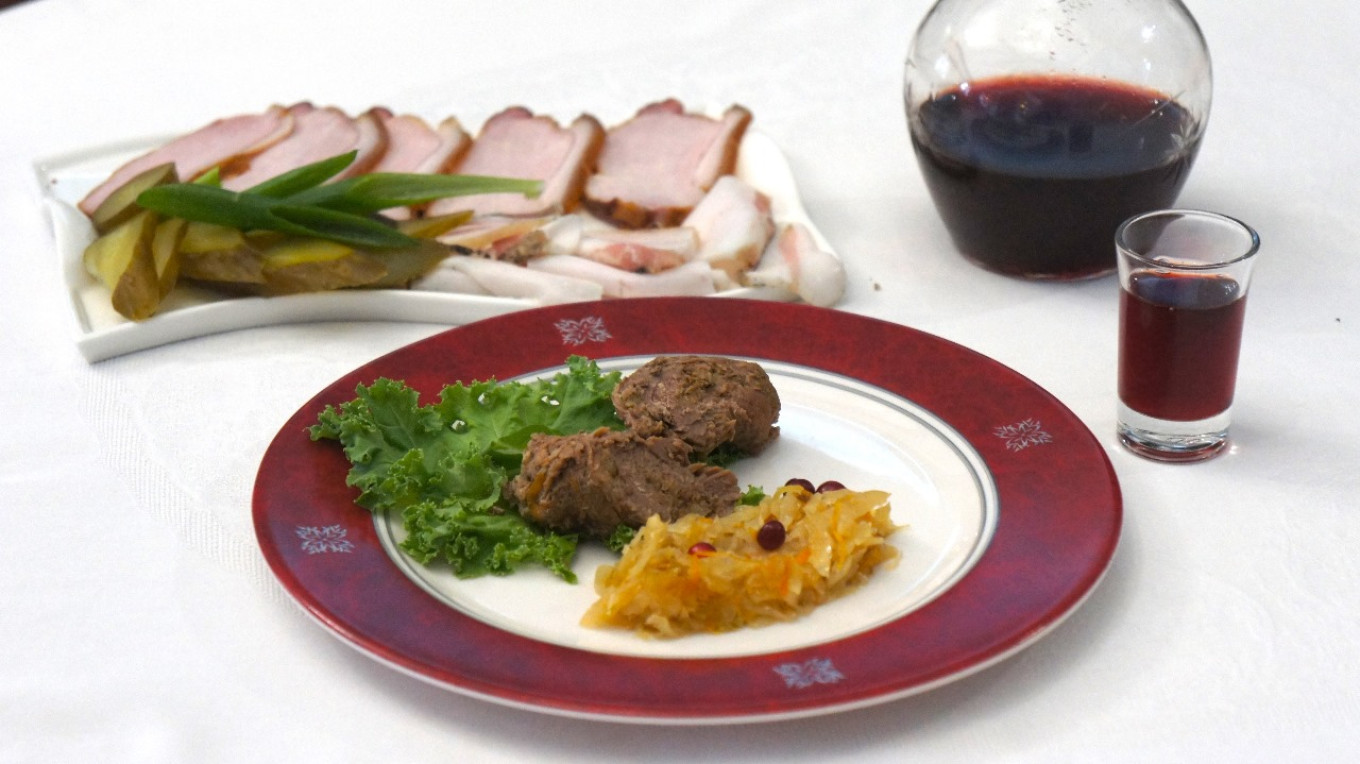
… we have a small favor to ask.
As you may have heard, The Moscow Times, an independent news source for over 30 years, has been unjustly branded as a “foreign agent” by the Russian government. This blatant attempt to silence our voice is a direct assault on the integrity of journalism and the values we hold dear.
We, the journalists of The Moscow Times, refuse to be silenced. Our commitment to providing accurate and unbiased reporting on Russia remains unshaken. But we need your help to continue our critical mission.
It’s quick to set up, and you can be confident that you’re making a significant impact every month by supporting open, independent journalism. Thank you.





